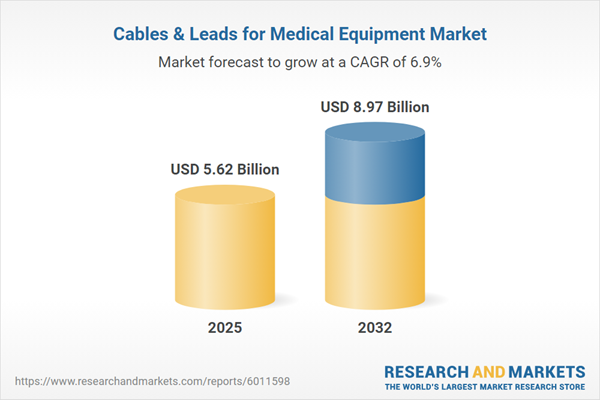Speak directly to the analyst to clarify any post sales queries you may have.
The Cables & Leads for Medical Equipment Market is undergoing significant transformation, fueled by innovations in digital health and evolving care models. Senior decision-makers are seeking actionable insights to navigate regulatory demands, supply chain volatility, and emerging technology trends in this sector.
Market Snapshot: Cables & Leads for Medical Equipment Market
The global market for medical equipment cables and leads is registering steady expansion, supported by rising investment in advanced diagnostic and therapeutic platforms. This growth is driven by the increasing use of digital health solutions and the proliferation of decentralized healthcare settings. Additionally, escalating compliance requirements and shifts in healthcare delivery are catalyzing demand for products that meet high performance and safety standards.
Scope & Segmentation
This report delivers a detailed analysis across the following categories and regions:
- Product Types: Defibrillator cables including paddle and patch cables; ECG cables featuring both limb lead (3-lead, 5-lead) and precordial configurations; non-invasive blood pressure (NIBP) cables for both automatic (double tube, single tube) and manual inflation; SpO2 sensor cables differentiated by reflectance and transmission technology (adult, neonatal, pediatric); temperature sensor cables utilizing thermistor and thermocouple technology; and ultrasound cables supporting convex, endocavity, linear, and phased array probes.
- End Users: Ambulatory surgical centers (contracted, owned), general and specialty clinics, diagnostic centers (imaging and pathology), home healthcare providers, and hospitals (private and public).
- Technologies: Both wired and wireless systems encompassing Bluetooth, proprietary, and Wi-Fi platforms.
- Connection Types: Banana, BNC, DIN, and LEMO connectors tailored to clinical workflow and performance attributes.
- Insulation Materials: PVC, Santoprene, silicone, and TPE, selected for flexibility, durability, and biocompatibility.
- Regions Covered: Americas (North America: United States, Canada, Mexico; Latin America: Brazil, Argentina, Chile, Colombia, Peru), Europe, Middle East & Africa (Europe: United Kingdom, Germany, France, Russia, Italy, Spain, Netherlands, Sweden, Poland, Switzerland; Middle East: United Arab Emirates, Saudi Arabia, Qatar, Turkey, Israel; Africa: South Africa, Nigeria, Egypt, Kenya), and Asia-Pacific (China, India, Japan, Australia, South Korea, Indonesia, Thailand, Malaysia, Singapore, Taiwan).
- Company Coverage: Detailed trend analysis and developments related to TE Connectivity Ltd., Amphenol Corporation, Smiths Group plc, Becton, Dickinson and Company, Medtronic plc, GE HealthCare Technologies Inc., Koninklijke Philips N.V., Drägerwerk AG & Co. KGaA, Mindray Medical International Limited, and Nihon Kohden Corporation.
Key Takeaways
- Strategic investments in wireless and hybrid cable technologies are enhancing patient monitoring, telehealth, and decentralized care delivery.
- Manufacturers are prioritizing supply chain resilience by diversifying sourcing strategies and forming regional partnerships to buffer geopolitical risks and trade challenges.
- Regulatory-driven standardization is accelerating, leading to increased adoption of interoperable devices, eco-friendly insulation, and recyclable connectors.
- Customization, including modular design and configurable interfaces, is offering competitive differentiation for meeting diverse clinical requirements.
- Segmental adoption varies: while hospitals and high-volume clinics prioritize advanced hybrid systems, home healthcare and ambulatory centers favor user-friendly, durable solutions.
- Major industry players are leveraging digital platforms for real-time inventory management, compliance automation, and predictive maintenance, supporting operational efficiency.
Tariff Impact
Recent United States tariffs on key raw materials and subcomponents have prompted manufacturers to reassess procurement strategies. Emphasis on localized production, material alternatives, and long-term supplier contracts is helping offset cost pressures. These adjustments are shaping sourcing patterns and supply chain configurations across the sector.
Methodology & Data Sources
This report applies a thorough multi-stage research methodology, including rigorous secondary research from journals and industry whitepapers, validated by primary interviews with industry executives, engineers, and clinical end users. Data triangulation and expert workshops ensure relevance and accuracy in market findings.
Cables & Leads for Medical Equipment Market: Why This Report Matters
- Equips leaders to adapt to evolving regulatory and technological requirements in the medical equipment supply chain.
- Provides segmentation insights for tactical product development, targeting, and risk management across regional and end-user landscapes.
- Delivers a competitive edge by profiling top industry players, innovation approaches, and supply chain strategies.
Conclusion
This report delivers a strategic lens for navigating innovation, compliance, and operational complexities in the medical equipment cables and leads market. Leaders equipped with these insights can pursue informed decisions and capitalize on growth opportunities in this evolving landscape.
Additional Product Information:
- Purchase of this report includes 1 year online access with quarterly updates.
- This report can be updated on request. Please contact our Customer Experience team using the Ask a Question widget on our website.
Table of Contents
3. Executive Summary
4. Market Overview
7. Cumulative Impact of Artificial Intelligence 2025
Companies Mentioned
The companies profiled in this Cables & Leads for Medical Equipment market report include:- TE Connectivity Ltd.
- Amphenol Corporation
- Smiths Group plc
- Becton, Dickinson and Company
- Medtronic plc
- GE HealthCare Technologies Inc.
- Koninklijke Philips N.V.
- Drägerwerk AG & Co. KGaA
- Mindray Medical International Limited
- Nihon Kohden Corporation
Table Information
| Report Attribute | Details |
|---|---|
| No. of Pages | 198 |
| Published | October 2025 |
| Forecast Period | 2025 - 2032 |
| Estimated Market Value ( USD | $ 5.62 Billion |
| Forecasted Market Value ( USD | $ 8.97 Billion |
| Compound Annual Growth Rate | 6.9% |
| Regions Covered | Global |
| No. of Companies Mentioned | 11 |









